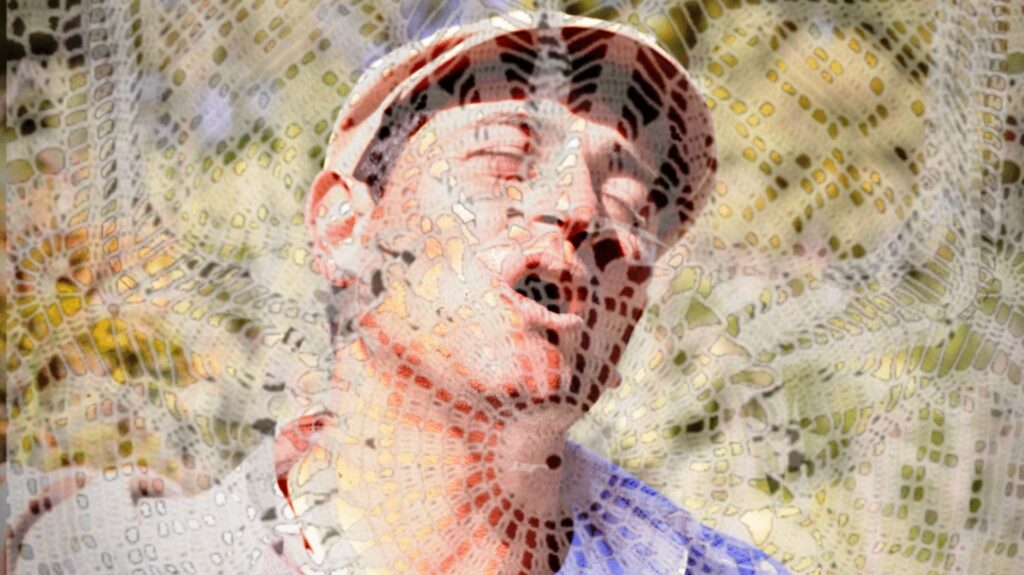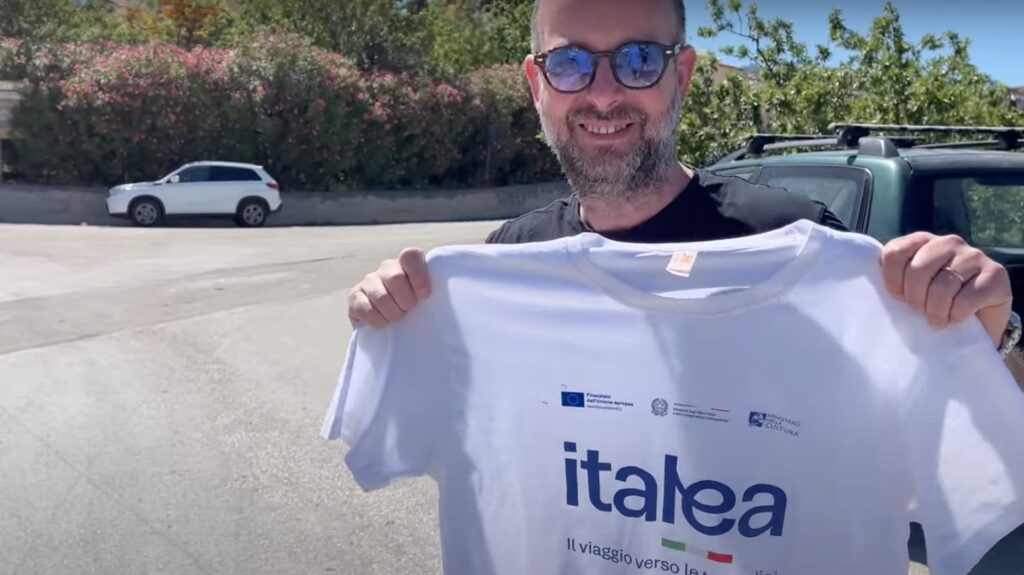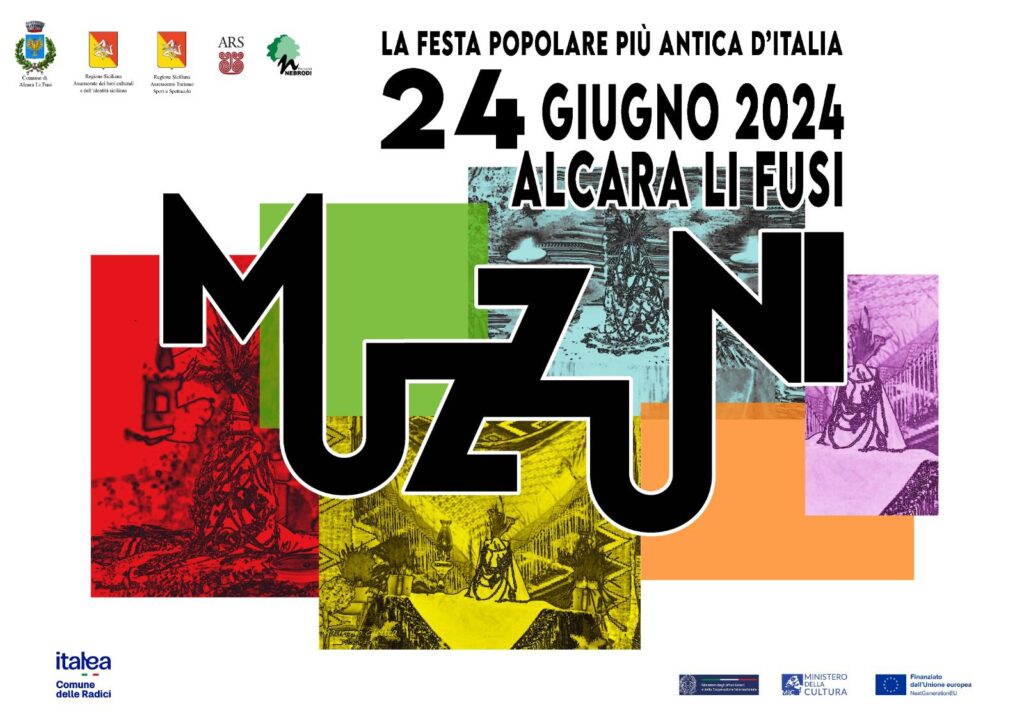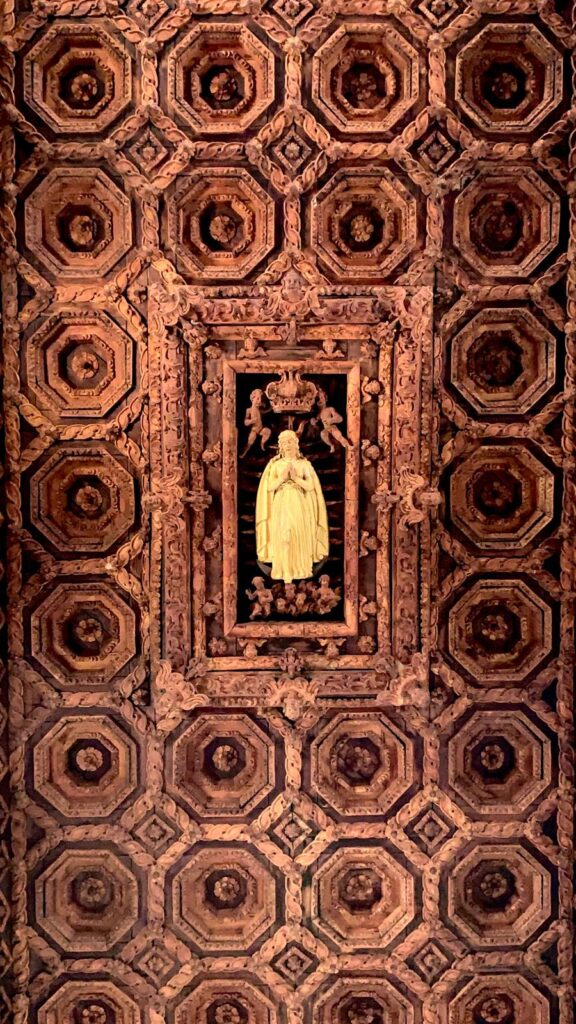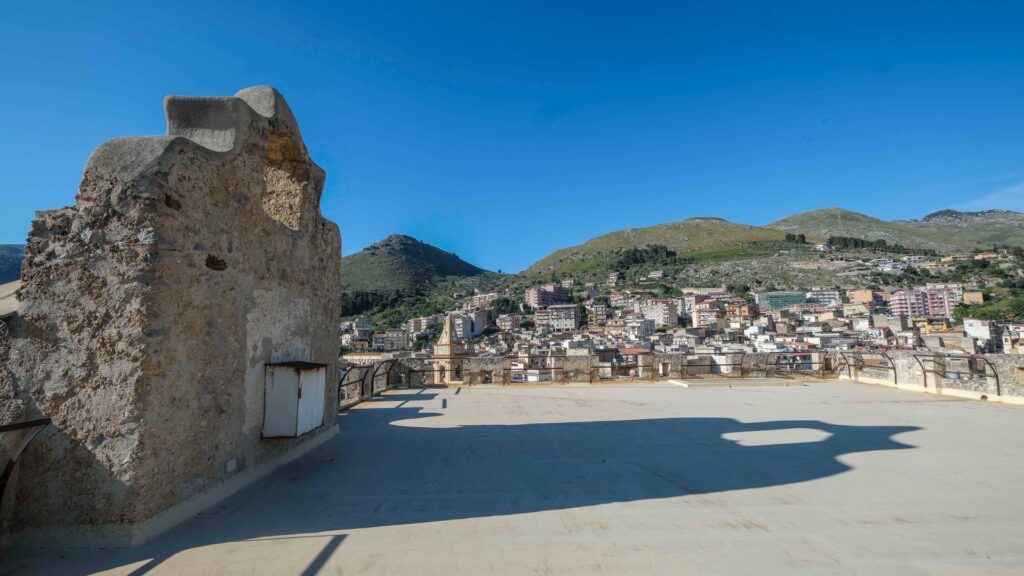There is Angelo di Sant’Angelo Muxaro, a shepherd with eyes of heaven; there is Vincenzo di Contessa Entellina who uses egg tempera on a gold background for his icons; there is Simone di San Biagio Platani who every year becomes one of the Madunnara and sews devotional arches; there is Caterina di Isnello who works the heavy “piduni”, there is Pietro di Giuliana, a peasant sculptor, there is Damiano, the magician of carved sticks, in Bompietro.
They are witnesses with an ancient face, guardians of a tradition that always passes through the hands, or young people who want to find a way that will take them back to their origins: six living treasures, six guardians of time who, each in their own way, are linked to the land and its centuries-old traditions.
Their photographs have become works of art and have flown to Los Angeles for a small, precious exhibition set up inside the Italy Village that houses the historic Amerigo Vespucci, the training ship of the Italian Navy; and where, until Monday 8 July, the Year of Italian Roots in the World will be discussed, and the Italea project of the Ministry of Foreign Affairs dedicated to Italians abroad and Italian-descendants.
The exhibition is in fact created by Italea Sicilia, the Sicilian rib of the project.
On the photographs – taken by journalist Giulio Giallombardo during the Borghi dei Tesori Roots Fest, the festival that enhances the heritage of small Sicilian municipalities – Domenico Pellegrino intervened and threw a network of thin textures, ancient lace, impalpable dreams and memories that draw on the collective memory.
Thus were born six author’s proofs, unique in their kind, already exhibited as part of Iconic Women, the exhibition that Pellegrino successfully presented last April at Milan Design Week.
And today the same photographs reach the United States where hundreds of thousands of Sicilians have emigrated, restoring the memory of the descendants of these protagonists from a distance.
“It is a small story of a Sicily that seems on the verge of disappearing, but which then discovers itself alive through flashes of humanity. On these faces, young custodians of ancient traditions or elderly witnesses of an era, threads are traced that knot generations, from Isnello to Sant’Angelo Muxaro, from Bompietro to Giuliana, up to San Biagio Platani and Contessa Entellina”, explains Giulio Giallombardo.
“On these images, transformed into digital signs, subtle textures are grafted, interweaving of which you can still feel the weight of the hand, the echo of physical work – Domenico Pellegrino intervenes – Impossible tattoo, almost invisible mutation: perhaps a sort of identification between the memory of an entirely local artisan tradition and the concreteness of the body, of presence”.
“Telling the best of Italy”.
Villaggio Italy, in the first stop in Los Angeles, has an area of 12 thousand square meters.
The Amerigo Vespucci will then follow in the other seven planned ports: Tokyo, Darwin, Singapore, Mumbai, Abu Dhabi, Doha and Jeddah.
THE PROTAGONISTS OF THE EXHIBITION
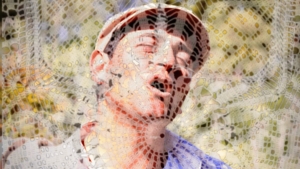
Angelo Greco, Dote Collection for Radici by Domenico Pellegrino on images by Giulio Giallombardo, dibond 30×45 cm
ANGELO GRECO – The shepherd with the eyes of heaven
A dream two hundred sheep long.
But who would have thought that for this boy, with his blue eyes sticking out from under his flat cap and illuminating a sunburnt face, the dream to be realized was to lead his animals to pasture.
Angelo Greco, a shepherd-aedo by profession: and this is not a fallback, not at all, Angelo has chosen not only to stay in his village on the Sicani, Sant’Angelo Muxaro, but also to take up a profession that has now almost been lost.
This is a harsh and soft land at the same time, it was chosen hundreds of years ago by the good Daedalus fleeing from the Cretan labyrinth, which found hospitality from the mysterious king Kokalos: even then on these hills the shepherds led their flocks and followed the seasons.
The same thing is done today by Angelo, who also has a secret: he is the only one, together with another Sant’Angelo, to know an ancient liturgical song, a hypnotic and vibrant lamentation that is still declaimed in the alleys of the village during the Good Friday procession.
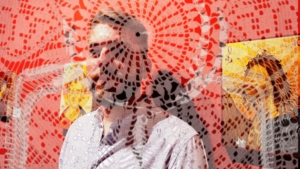
Vincenzo Bruno, Dote Collection for Radici by Domenico Pellegrino on images by Giulio Giallombardo, dibond 30×45 cm
VINCENZO BRUNO – The young icon painter Arbëreshë
Egg tempera on a gold background almost shines: it is an ancient technique, widely used between the twelfth and fourteenth centuries in Europe and above all, in the art linked to the Orthodox churches.
Technique that Vincenzo Bruno has taken up and made perfect.
From the painstaking work of the young artist, bent over for hours on a single artifact illuminated by a single lamp, icons that look like jewels are born.
Vincenzo has been creating beautiful works for years, letting himself be inspired (and transported) by the Byzantine style, but in this case, unlike tradition, his icons are made of ceramic, to ensure better conservation.
And it does not seem strange that this art was reborn in the small village of Contessa Entellina: we are in the heart of the Arbëreshë tradition here – in addition to Contessa, also Piana degli Albanesi, Palazzo Adriano, Santa Cristina Gela and Mezzojuso – Albanian refugees fleeing from the Ottomans arrived.
And with them they brought the few possessions and icons, the only link with the religious tradition of the land that they were forced to abandon.
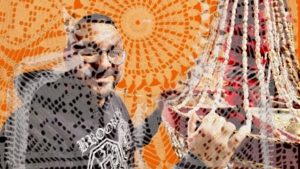
Simone De Marco, Dowry Collection for Radici by Domenico Pellegrino on images by Giulio Giallombardo, dibond 30×45 cm
SIMONE DE MARCO – The Arches born from an entire community
Gnocchi for sunflowers, orecchiette for almond trees, small roses of colored pasta, grains and legumes: this is the whole town that for months has been setting in motion to recreate, every year, the traditional bread arches of San Biagio Platani.
The preparation of the arches is very complex, since they are all ephemeral architectures, every year we start from scratch: reeds and willow stems are pressed to cover the iron frames that will form the famous arches from which the decorated Nymphs (similar to sumptuous chandeliers) will hang.
There are the two working factions: the Madunnara are more inclined to blue, the Signurara marry more grains and legumes: among them there is Simone De Marco who left for London and returned, as an adult boy, to find himself in his country.
In San Biagio everyone works: the men bend the iron, the women knead the bread to be decorated, the children pierce legumes, the girls compose mandalas of seeds or pasta flowers: at the end of this extraordinary work, the town dresses up for the holidays.
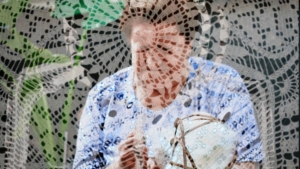
Caterina Di Martino, Dote Collection for Radici by Domenico Pellegrino on images by Giulio Giallombardo, dibond 30×45 cm
CATERINA DI MARTINO – The aunt who works the heavy “piduni”
Aunt Caterina is known everywhere in Isnello, the small village perched on the Madonie, where every church is a jewel and astronomy is discussed in the houses: from the light fingers of the old woman flowers, butterflies, impalpable lace, ancient filet grow, the same ones that flourished on the brides’ trousseau.
But the profession of the past is also found in another job, which Caterina Di Martino, together with other women from Isnello, realizes: from her precious hands are also born the “piduna”, the heavy wool socks worn by shepherds, warm in winter and cool in summer, a true thermometer of the seasons that inexorably always return.
It is ancient art, no one makes them anymore, yet they are highly sought after, and not only on the Madonie.
And those of Aunt Caterina also have another quality, they are made only with the wool of the sheep that the artisan breeds and knows one by one.
In Isnello there is a very long textile tradition, told by the Trame di filo museum.
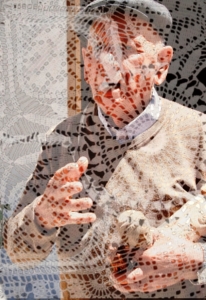
Pietro Principato, Dote Collection for Radici by Domenico Pellegrino on images by Giulio Giallombardo, dibond 45×30 cm
PIETRO PRINCIPATO – Zu’Pietro, peasant sculptor in Sican land
He cuts with a knife, clean, fast cuts, as if he were caressing olive or walnut wood: but above all, he has been engraving for over ninety years.
Pietro Principato for everyone is zu’ Pietro, he lives in Giuliana indeed, he returned to Giuliana after many years spent in Germany to seek his fortune, and after a bad injury that forced him to a wheelchair for years.
So zu’ Pietro has recovered the cuts, the caresses to the wood that he used to make when, as a boy, he led the animals to pasture and spent very long hours alone on the surrounding hills.
Sculptor-farmer in Sican land, from his fingers comes a small world of hieratic figurines, bas-reliefs, Sicilian glimpses, with an ancient trait, which seem to shake hands from afar at certain finds that overlook archaeological museums.
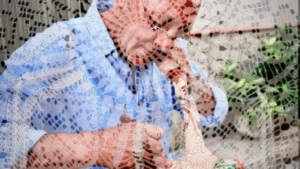
Damiano Sabatino, Dote Collection for Radici by Domenico Pellegrino on images by Giulio Giallombardo, dibond 30×45 cm
DAMIANO SABATINO – The Sicilian wizard of carved sticks
Damiano Sabatino is a living treasure of Unesco, his carved sticks have a unique and very particular style.
He is an architect-carver who works with wood, creating artifacts that are true works of art.
Personalized sticks, but not only.
His art was born as an emigrant, when he worked in the Upper Varese area, an area with many woods similar to those of the Madonie.
To make the days shorter, Damiano recovered the ancient habit of shepherds, carving wood.
His works are beautiful to look at, but they also have a story to tell.
They are all objects with a soul, such as the stick with Bluebeard of Petralia, or the one dedicated to the Madonna dell’Alto.
They are made of rowan wood, the hardest, especially if you temper it with fire first.
Or in hawthorn, which must be harvested with the waning moon: by following this little secret, wood can be worked much better.
